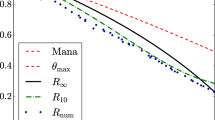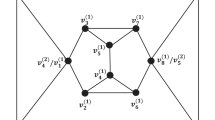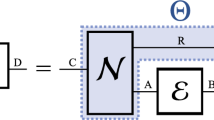Abstract
Quantum computers promise dramatic advantages over their classical counterparts, but the source of the power in quantum computing has remained elusive. Here we prove a remarkable equivalence between the onset of contextuality and the possibility of universal quantum computation via ‘magic state’ distillation, which is the leading model for experimentally realizing a fault-tolerant quantum computer. This is a conceptually satisfying link, because contextuality, which precludes a simple ‘hidden variable’ model of quantum mechanics, provides one of the fundamental characterizations of uniquely quantum phenomena. Furthermore, this connection suggests a unifying paradigm for the resources of quantum information: the non-locality of quantum theory is a particular kind of contextuality, and non-locality is already known to be a critical resource for achieving advantages with quantum communication. In addition to clarifying these fundamental issues, this work advances the resource framework for quantum computation, which has a number of practical applications, such as characterizing the efficiency and trade-offs between distinct theoretical and experimental schemes for achieving robust quantum computation, and putting bounds on the overhead cost for the classical simulation of quantum algorithms.
This is a preview of subscription content, access via your institution
Access options
Subscribe to this journal
Receive 51 print issues and online access
$199.00 per year
only $3.90 per issue
Buy this article
- Purchase on Springer Link
- Instant access to full article PDF
Prices may be subject to local taxes which are calculated during checkout


Similar content being viewed by others
References
Shor, P. W. in Proc. IEEE Foundations of Computer Science (FOCS) (ed. Goldwasser, S. ) 124–134 http://dx.doi.org/10.1109/SFCS.1994.365700 (IEEE Computer Society, 1994)
Lloyd, S. Universal quantum simulators. Science 273, 1073–1078 (1996)
Deutsch, D. Quantum theory, the Church-Turing principle and the universal quantum computer. Proc. R. Soc. A. 400, 97–117 (1985)
Vidal, G. Efficient classical simulation of slightly entangled quantum computations. Phys. Rev. Lett. 91, 147902 (2003)
Datta, A., Shaji, A. & Caves, C. M. Quantum discord and the power of one qubit. Phys. Rev. Lett. 100, 050502 (2008)
Steane, A. M. A quantum computer only needs one universe. Preprint at http://arxiv.org/abs/quant-ph/0003084 (2000)
Vedral, V. The elusive source of quantum speedup. Found. Phys. 40, 1141–1154 (2010)
Brodutch, A. Discord and quantum computational resources. Phys. Rev. A 88, 022307 (2013)
Van den Nest, M. Universal quantum computation with little entanglement. Phys. Rev. Lett. 110, 060504 (2013)
Knill, E. & Laflamme, R. Power of one bit of quantum information. Phys. Rev. Lett. 81, 5672–5675 (1998)
Briegel, H. J., Browne, D. E., Dür, W., Raussendorf, R. & Van den Nest, M. Measurement-based quantum computation. Nature Phys. 5, 19–26 (2009)
Bell, J. On the problem of hidden variables in quantum mechanics. Rev. Mod. Phys. 38, 447–452 (1966)
Kochen, S. & Specker, E. P. The problem of hidden variables in quantum mechanics. J Math. Mech. 17, 59–87 (1968)
Bravyi, S. & Kitaev, A. Universal quantum computation with ideal Clifford gates and noisy ancillas. Phys. Rev. A 71, 022316 (2005)
Knill, E. Quantum computing with realistically noisy devices. Nature 434, 39–44 (2005)
Campbell, E. T., Anwar, H. & Browne, D. E. Magic state distillation in all prime dimensions using quantum Reed-Muller codes. Phys. Rev. X 2, 041021 (2012)
Mermin, N. D. Simple unified form for the major no-hidden-variables theorems. Phys. Rev. Lett. 65, 3373–3376 (1990)
Buhrman, H., Cleve, R., Massar, S. & de Wolf, R. Nonlocality and communication complexity. Rev. Mod. Phys. 82, 665–698 (2010)
Acín, A. et al. Device-independent security of quantum cryptography against collective attacks. Phys. Rev. Lett. 98, 230501 (2007)
Reichardt, B. W., Unger, F. & Vazirani, U. Classical command of quantum systems. Nature 496, 456–460 (2013)
Vazirani, U. & Vidick, T. Fully device independent quantum key distribution. Preprint at http://arxiv.org/abs/1210.1810 (2012)
Raussendorf, R. Contextuality in measurement-based quantum computation. Phys. Rev. A 88, 022322 (2013)
Hoban, M. J., Wallman, J. J. & Browne, D. E. Generalized Bell-inequality experiments and computation. Phys. Rev. A 84, 062107 (2011)
Gottesman, D. Theory of fault-tolerant quantum computation. Phys. Rev. A 57, 127–137 (1998)
Yu, A. Fault-tolerant quantum computation by anyons. Ann. Phys. 303, 2–30 (2003)
Raussendorf, R., Harrington, J. & Goyal, K. A fault-tolerant one-way quantum computer. Ann. Phys. 321, 2242–2270 (2006)
Dennis, E., Kitaev, A., Landahl, A. & Preskill, J. Topological quantum memory. J. Math. Phys. 43, 4452–4505 (2002)
Anwar, H., Brown, B. J., Campbell, E. T. & Browne, D. E. Efficient decoders for qudit topological codes. Preprint at http://arxiv.org/abs/1311.4895 (2013)
Fowler, A. G., Mariantoni, M., Martinis, J. M. & Cleland, A. N. Surface codes: towards practical large-scale quantum computation. Phys. Rev. A 86, 032324 (2012)
Aaronson, S. & Gottesman, D. Improved simulation of stabilizer circuits. Phys. Rev. A 70, 052328 (2004)
Cabello, A., Severini, S. & Winter, A. (Non-)Contextuality of physical theories as an axiom. Preprint at http://arxiv.org/abs/1010.2163 (2010)
Cabello, A., Severini, S. & Winter, A. Graph-theoretic approach to quantum correlations. Phys. Rev. Lett. 112, 040401 (2014)
Cormick, C., Galvão, E. F., Gottesman, D., Pablo Paz, J. & Pittenger, A. O. Classicality in discrete Wigner functions. Phys. Rev. A 73, 012301 (2006)
Howard, M. & Vala, J. Qudit versions of the qubit π/8 gate. Phys. Rev. A 86, 022316 (2012)
Veitch, V., Ferrie, C., Gross, D. & Emerson, J. Negative quasi-probability as a resource for quantum computation. N. J. Phys. 14, 113011 (2012)
Mari, A. & Eisert, J. Positive Wigner functions render classical simulation of quantum computation efficient. Phys. Rev. Lett. 109, 230503 (2012)
van Dam, W. & Howard, M. Noise thresholds for higher-dimensional systems using the discrete Wigner function. Phys. Rev. A 83, 032310 (2011)
Appleby, D. M., Bengtsson, I. & Chaturvedi, S. Spectra of phase point operators in odd prime dimensions and the extended Clifford group. J. Math. Phys. 49, 012102 (2008)
Wallman, J. J. & Bartlett, S. D. Non-negative subtheories and quasiprobability representations of qubits. Phys. Rev. A 85, 062121 (2012)
Gross, D. Hudson’s theorem for finite-dimensional quantum systems. J. Math. Phys. 47, 122107 (2006)
Wootters, W. K. The discrete Wigner function. Ann. NY Acad. Sci. 480, 275–282 (1986)
Gibbons, K. S., Hoffman, M. J. & Wootters, W. K. Discrete phase space based on finite fields. Phys. Rev. A 70, 062101 (2004)
Östergård, P. R. J. A fast algorithm for the maximum clique problem. Discrete Appl. Math. 120, 197–207 (2002)
Veitch, V., Mousavian, S. A. H., Gottesman, D. & Emerson, J. The resource theory of stabilizer computation. N. J. Phys. 16, 013009 (2014)
Howard, M., Brennan, E. & Vala, J. Quantum contextuality with stabilizer states. Entropy 15, 2340–2362 (2013)
Peres, A. Two simple proofs of the Kochen-Specker theorem. J. Phys. A 24, L175–L178 (1991)
Spekkens, R. W. Contextuality for preparations, transformations, and unsharp measurements. Phys. Rev. A 71, 052108 (2005)
Acín, A., Fritz, T., Leverrier, A. & Sainz, A. B. A combinatorial approach to nonlocality and contextuality. Preprint at http://arxiv.org/abs/1212.4084 (2012)
Acknowledgements
M.H. was supported by the Irish Research Council (IRC) as part of the Empower Fellowship programme, and all authors acknowledge support from CIFAR and the Government of Canada through NSERC.
Author information
Authors and Affiliations
Contributions
All authors made significant contributions to the results, interpretation and presentation of this Article.
Corresponding author
Ethics declarations
Competing interests
The authors declare no competing financial interests.
Supplementary information
Supplementary information
This file contains the extended mathematical proof of the part of Theorem 1 pertaining to the independence number. (PDF 273 kb)
PowerPoint slides
Rights and permissions
About this article
Cite this article
Howard, M., Wallman, J., Veitch, V. et al. Contextuality supplies the ‘magic’ for quantum computation. Nature 510, 351–355 (2014). https://doi.org/10.1038/nature13460
Received:
Accepted:
Published:
Issue Date:
DOI: https://doi.org/10.1038/nature13460
This article is cited by
-
Optimal measurement structures for contextuality applications
npj Quantum Information (2023)
-
An effective way of characterizing the quantum nonlocality
Quantum Information Processing (2023)
-
Separability, Contextuality, and the Quantum Frame Problem
International Journal of Theoretical Physics (2023)
-
Local-dimension-invariant Calderbank–Shor–Steane codes with an improved distance promise
Quantum Information Processing (2023)
-
Violating the KCBS Inequality with a Toy Mechanism
Foundations of Science (2023)
Comments
By submitting a comment you agree to abide by our Terms and Community Guidelines. If you find something abusive or that does not comply with our terms or guidelines please flag it as inappropriate.



